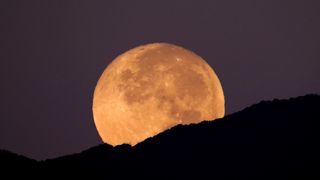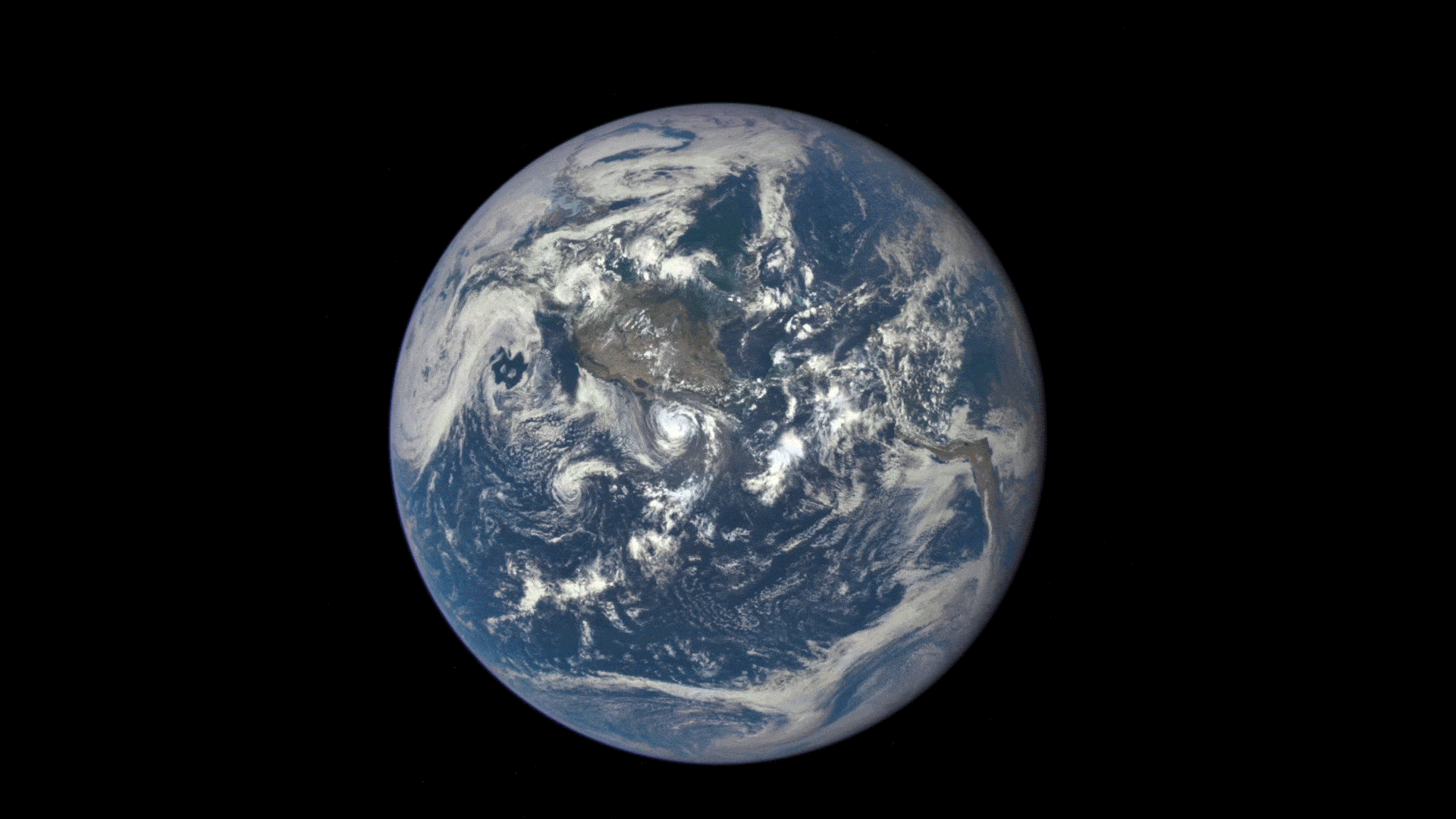How big is the moon?
The moon is a little more than one quarter the size of Earth.

Earth's moon is the brightest object in our night sky. But how big is the moon? The moon's mean radius is 1,079.6 miles (1,737.5 kilometers) and the mean diameter is 2,159.2 miles (3,475 km). Compared to Earth, the moon is less than a third the width of our home planet, according to NASA. The moon's equatorial circumference is 6,783.5 miles (10,917 km).
At first, the moon may appear quite large, but that is only because it is our closest celestial body — approximately 238,855 miles (384,400 km) away on average.
– Radius: 1,079.6 miles (1,737.5 km)
– Diameter: 2,159.2 miles (3,475 km).
– Surface area: 14.6 million square miles (38 million square km)
– Mass: 7.35 x 10^22 kg
– Density: 3.34 grams per cubic centimeter (3.34 g/cm3)
The moon is a bit more than one-quarter (27 percent) the size of Earth, a much larger ratio (1:4) than any other planets and their moons. Earth's moon is the fifth largest moon in the solar system.
"If Earth were the size of a nickel, the moon would be about as big as a coffee bean," according to a statement from NASA.
The moon's surface area is about 14.6 million square miles (38 million square km), which is less than the total surface area of the continent of Asia (17.2 million square miles or 44.5 million square km).
Related: Does the moon rotate?
Moon mass, density and gravity
The moon's mass is 7.35 x 1022 kg, about 1.2% of Earth's mass. Put another way, Earth weighs 81 times more than the moon. The moon's density is 3.34 grams per cubic centimeter (3.34 g/cm3). That is about 60% of Earth's density.
The moon's gravitational force is only about 16.6 % of Earth's gravity which means a person would weigh six times less on the moon than they do on Earth. A 45-kilogram person would weigh 100 lbs. on Earth but only 16.6 lbs. on the moon. Long jump events on the lunar surface would certainly be interesting as a person who can jump up 10 feet on Earth would be able to jump almost 60 feet on the moon.
Like most of the solar system worlds, the moon's gravity varies based on its surface features. In 2012, NASA's Gravity Recovery and Interior Laboratory (GRAIL) mission mapped the moon's gravity in unprecedented detail.
The moon is the second densest moon in the solar system; Jupiter's moon Io is denser, with 3.53 g/cm3.
"What this map tells us is that more than any other celestial body we know of, the moon wears its gravity on its sleeve," GRAIL principal investigator Maria Zuber of the Massachusetts Institute of Technology said in a statement. "When we see a notable change in the gravity field, we can sync up this change with surface topography features such as craters, rilles or mountains."
While the moon is the closest and one of the longest studied astronomical objects, scientists continue to press the celestial body for details.
"The moon is the Rosetta Stone by which we understand the rest of the solar system," Noah Petro, deputy project scientist for NASA's Lunar Reconnaissance Orbiter (LRO) mission, said in a statement.

How does our moon compare to others in the solar system?
According to the science education website The Nine Planets (they still love Pluto), our moon is the biggest in the solar system relative to the size of its planet, it is the fifth-biggest overall. Jupiter's moon Ganymede is the largest moon in the solar system.
| Rank | Moon | Equatorial radius | Parent planet |
|---|---|---|---|
| 1 | Ganymede | 1,635 miles (2,631 km) | Jupiter |
| 2 | Titan | 1,600 miles (2,575 km) | 1,600 miles (2,575 km) Saturn |
| 3 | Callisto | 1,497 miles (2,410.3 km) | Jupiter |
| 4 | Io | 1,131.7 miles (1,821.6 km) | Jupiter |
| 5 | The moon | 1,079.6 miles (1,737.5 km) | Earth |
| 6 | Europa | 969.84 miles (1,560.8 km) | Jupiter |
| 7 | Triton | 840.96 miles (1,353.4 km) | Neptune |
| 8 | Titania | 490.19 miles (788.9 km) | Uranus |
| 9 | Rhea | 474.91 miles (764.3 km) | Saturn |
| 10 | Oberon | 473.11 miles (761.4 km) | Uranus |
Supermoon

Have you ever gazed up and the night sky and thought "why is the moon so big tonight?". The answer is in the moon's orbit. Because the moon's orbit is not circular, it is sometimes closer than at other times. When the moon is closest to Earth — approximately 226,000 miles (363,300 km) –it is known as Perigee, according to an article by NASA. When a full moon coincides with perigee, we get a supermoon, which appears 14 percent larger and 30 percent brighter than usual.
First applied by astrologer Richard Nolle in 1979, "supermoon" originally referred to a new or full moon that occurs when the moon is within 90 percent of its closest approach to Earth. The astronomical term for the phenomena is a perigee-syzygy moon. According to NASA Jet Propulsion Laboratory "Syzygy is the alignment of three celestial bodies, in this case, the Sun, Moon and Earth. But that doesn't quite roll off the tongue as easily as supermoon".
The difference isn't always obvious; according to NASA, "A 30 percent difference in brightness can be easily masked by clouds or the competing glare of urban lights."
"The main reason why the orbit of the moon is not a perfect circle is that there are a lot of tidal, or gravitational, forces that are pulling on the moon," Petro told Space.com, adding that the gravity of the Earth, sun and planets of our solar system all impact the orbit of the moon. "You have all of these different gravitational forces pulling and pushing on the moon, which gives us opportunities to have these close passes."
A supermoon occurs about every 414 days. That's an average, however; the year 2016 boasted not one but three supermoons. The moon won't get as close to Earth as it got during the November 2016 supermoon until November 25, 2034.
Why does the moon look big when rising or setting near the horizon?

It's all an illusion. A little-understood optical effect can make the moon seem bigger when rising behind distant objects on the horizon. This trick of the brain — known either as the moon illusion or the Ponzo illusion — has been observed since ancient times, but still has no generally accepted explanation, according to NASA.
One theory holds that we're used to seeing clouds just a few miles above us, while we know that clouds on the horizon can be tens of miles distant. If a cloud on the horizon is the same size as clouds normally are overhead despite its great distance, we know it must be huge. And because the moon near the horizon is the same size as it normally is overhead, our brains automatically tack on a similar size increase.
But not everyone thinks clouds have worked their magic on our brains to such a great extent. One alternative hypothesis holds that the moon seems larger near the horizon because we can compare its size to nearby trees and other objects on Earth — and it looms large in comparison. Overhead, amid the vast expanse of outer space, the moon seems diminutive.
One way to test whether it's just an illusion is to hold your thumb up next to the moon and compare the moon's size with your thumbnail. When the moon is higher in the sky, look at it again; the moon will be the same size compared to your thumbnail.
Additional resources
Looking for more fast moon facts, these educational infographics by ESA have got you covered. Curious to see how much you would weigh on other worlds, this fun interactive activity from the science museum Exploratorium will tell you! If you would like to read more about the Ponzo illusion, The Illusion Index from the University of Glasgow has a large collection of illusions for you to explore.
Bibliography
- Lo Presto, Michael C. "How big is the Moon?." The Physics Teacher 38.3 (2000): 179-180.
- Rudrauf, David, Daniel Bennequin, and Kenneth Williford. "The moon illusion explained by the projective consciousness model." Journal of Theoretical Biology 507 (2020): 110455.
- Schmidt, Johann Friedrich Julius. "Size and Mass of the Moon." The Moon. Springer, Cham, 2020. 7-7
Join our Space Forums to keep talking space on the latest missions, night sky and more! And if you have a news tip, correction or comment, let us know at: community@space.com.
Get the Space.com Newsletter
Breaking space news, the latest updates on rocket launches, skywatching events and more!

- Nola Taylor TillmanContributing Writer
